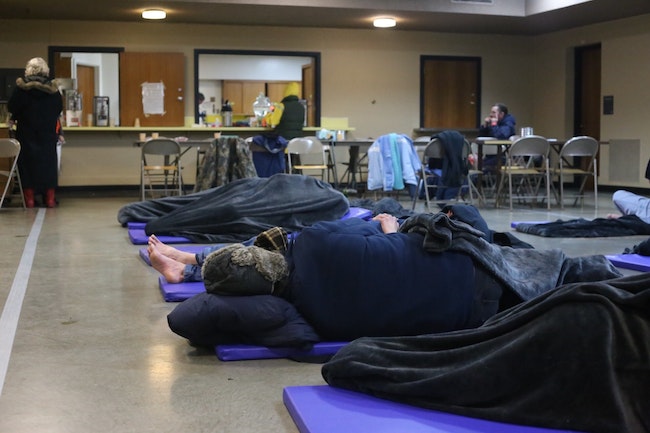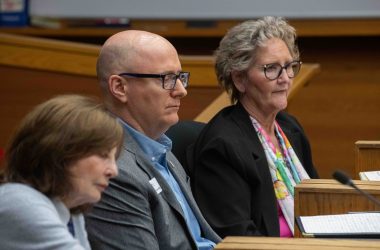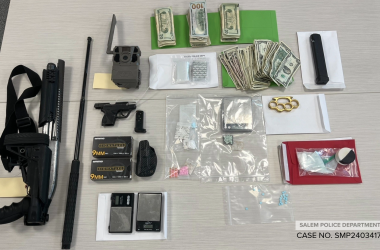 People sleep on mats at a warming shelter at First Presbyterian Church during a cold snap in January. (Troy Brynelson/Salem Reporter)
People sleep on mats at a warming shelter at First Presbyterian Church during a cold snap in January. (Troy Brynelson/Salem Reporter)
As Salem works on a stopgap to shelter homeless residents overnight this winter, a recently published study by the state of Oregon suggested it could help the city with a more permanent fix.
The Oregon Statewide Shelter Study found the state should help Salem and Eugene build “navigation centers,” which are open around-the-clock to anyone; and help people find aid for housing and health, among other concerns.
“Navigation centers can help these cities end encampments and assist other unsheltered homeless individuals,” wrote Technical Assistance Collaborative. The Boston firm produced the 115-page study for the Oregon Department of Housing and Community Services.
“TAC recommends that the state consider supporting the development of navigation centers in Eugene and Salem,” the firm wrote.
While the study came out in August, its findings are becoming more relevant to Salem officials looking for more places for homeless residents to sleep at night.
“It plays a huge role,” said Mayor Chuck Bennett of the study. “It indicates that the state wants to be a participant. The kind of funding that’s going to be required – both (construction), as well as operations – is going to take more than the city can handle inside its budget.”
Salem City Council agreed on Monday to give more than $200,000 to a local nonprofit and local churches to open two warming shelters more often during the winter months. The move aims to bring about 140 beds to homeless campers to use when a ban on public camping starts Dec. 16.
The new hours, however, may end by April 1. Councilors say they need to find a more permanent place by then.
OHCS, the state agency that produced the report, will have about $3.3 million to give out around the state to places that want to build more shelter. A spokesman said applications for a cut of that funding may not be available until late spring or early summer.
Still, Bennett said the city – if it wants the state’s help – needs to start planning. That could mean finding a place to build it and a budget.
“What I think is often expected by the state is that you’ll be ready if they come forward to help,” he said. “That we’re not just saying ‘Help us out.’”
Urban Development Director Kristin Retherford said plans haven’t started yet because conversations around navigation centers only recently started. Besides planning for locations and a budget, she said they will look at local nonprofits to help.
“It’s something that I think we will start exploring,” Retherford said. “I do think we’ll be hearing more about it.”
Navigation centers are “emerging” as a kind of shelter that doesn’t split men from women or restrict what they can bring inside, the study said. They may also be more welcoming to people with problems staying sober.
“Oftentimes people in need of resources bounce between nonprofits and resource centers,” said Nicole Stoenner, spokeswoman for OHCS. She said they are considered a “best practice.”
Stoenner added that Salem and Eugene stood out as places to help build navigation centers because of their large homeless populations. Portland already has a navigation center.
Headcounts of homeless residents vary in their results, but nonprofits in Salem believe there are between 1,300 and 1,800 in the region. Data provided by OHCS counts more than 2,000 in Lane County and around 4,000 in Multnomah County.
There are overnight shelters in Salem already. The Salvation Army Lighthouse Shelter has capacity to shelter more than 80 people. United Way of the Mid-Willamette Valley and Inside Out Ministries is also launching on Dec. 15 a new overnight shelter for 10 homeless women.
Union Gospel Mission of Salem offers men 150 beds, plus 48 extra mats from November through March. The organization’s Simonka Place has 100 beds for women and children.
The organization splits men from women – and keeps pets from staying overnight, as well as other restrictions – because otherwise it becomes a lot harder to manage, said Executive Director Dan Clem.
“Partners, pets, shopping carts, we just don’t have the capacity for right now,” he said. “It’s tremendously difficult and expensive to be able to provide more than just a bed and something to eat.”
Clem did say the shelters are “low-barrier” shelters, but not necessarily as low as what a navigation center or the warming shelters offer.
Those familiar with the navigation center model say it’s open to “all-comers.”
“Men, women, pets, shopping carts, pretty much anything,” said Jimmy Jones, executive director of the Mid-Willamette Valley Community Action Agency. “But has to have a goal attached to it: get those folks into (housing). It’s not so we can warehouse them there.”
The state’s study doesn’t say how much it would cost, generally, to run a navigation center.
Have a tip? Contact reporter Troy Brynelson at 503-575-9930, [email protected] or @TroyWB.









